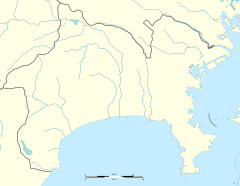Shōnandai Station
 East side of the station in May 2012 | |||||||||||||||||||||||||||||||||||||||||||
| General information | |||||||||||||||||||||||||||||||||||||||||||
| Location | 2-15 Shōnandai, Fujisawa-shi, Kanagawa-ken 252-0804 Japan | ||||||||||||||||||||||||||||||||||||||||||
| Coordinates | 35°23′46″N 139°28′00″E / 35.396185°N 139.466589°E | ||||||||||||||||||||||||||||||||||||||||||
| Operated by | |||||||||||||||||||||||||||||||||||||||||||
| Line(s) | |||||||||||||||||||||||||||||||||||||||||||
| Platforms | 2 side + 2 island platforms | ||||||||||||||||||||||||||||||||||||||||||
| Connections | |||||||||||||||||||||||||||||||||||||||||||
| Other information | |||||||||||||||||||||||||||||||||||||||||||
| Station code | B01 (Subway) | ||||||||||||||||||||||||||||||||||||||||||
| History | |||||||||||||||||||||||||||||||||||||||||||
| Opened | 7 November 1966 | ||||||||||||||||||||||||||||||||||||||||||
| Passengers | |||||||||||||||||||||||||||||||||||||||||||
| FY2019 | 168,796 | ||||||||||||||||||||||||||||||||||||||||||
| Services | |||||||||||||||||||||||||||||||||||||||||||
| |||||||||||||||||||||||||||||||||||||||||||
| Location | |||||||||||||||||||||||||||||||||||||||||||
Shōnandai Station (湘南台駅, Shōnandai-eki) is an interchange passenger railway station in located in the city of Fujisawa, Kanagawa, Japan, jointly operated by private railway companies Odakyu Electric Railway and Sagami Railway (Sōtetsu), and the public Yokohama City Transportation Bureau (subway service). It is 15.8 kilometers from the starting point of the Odakyū Enoshima Line at Sagami-Ōno Station and is a terminal station for both the Sagami Railway Izumino Line and the Yokohama Subway Blue Line.
The ticket gates of the three lines converge on one wide underground concourse.
Lines[edit]
- Odakyu Electric Railway
- Odakyū Enoshima Line - Rapid Express and Express trains stop at this station.
- Sagami Railway
- Yokohama Municipal Subway
- Blue Line (B01)
Station layout[edit]
The Odakyu Enoshima Line has two elevated opposed side platforms, connected to the station building by an underpass. The Sōtetsu and Yokohama Municipal Subway stations are both underground, and each have a single island platform.
Odakyu platforms[edit]
| 1 | OE Odakyū Enoshima Line | for Fujisawa and Katase-Enoshima |
| 2 | OE Odakyū Enoshima Line | for Yamato, Sagami-Ōno, Machida, and Shinjuku |
-
Ticket gates
-
Platform
Sōtetsu platforms[edit]
| 1, 2 | for Futamata-gawa, Yokohama and Shin-Yokohama |
-
Ticket gates
-
Platform
Yokohama Municipal Subway platforms[edit]
| 1, 2 | for Totsuka, Kamiōoka, Yokohama, Shin-Yokohama, and Azamino |
-
Ticket gates
-
Platform
History[edit]
This section needs additional citations for verification. (March 2023) |
Shōnandai Station was opened on November 7, 1966 as a station on the Odakyū Enoshima Line. The station was greatly expanded in 1999 with the addition of the Sagami Railway Izumino Line on March 10, and the Yokohama Subway Blue Line on August 29.
Through services to and from the Tokyu Toyoko Line courtesy of the Shin-yokohama Line began operation on 18 March 2023.[1] Effective this date, through services originating from this station continue past Hiyoshi on the Tokyu Shin-yokohama Line towards Wakoshi on the Yurakucho Line.
Passenger statistics[edit]
In fiscal 2019, the Odakyu station was used by an average of 92,076 passengers daily.[2] During the same fiscal year, the Sotetsu station was used by an average of 28,697 passengers daily,[3] and the Yokohama Municipal Subway by an average of 48,023 passengers daily,[4]
The passenger figures for previous years are as shown below.
| Fiscal year | Odakyu | Sotetsu | Yokohama Subway | |
|---|---|---|---|---|
| 2005 | 76,247 | 24,440 | 45,235 | [5] |
| 2010 | 82,948 | 26,741 | 44,431 | [6] |
| 2015 | 90,208 | 27,533 | 47,371 | [7] |
Surrounding area[edit]
Public facilities[edit]
- Shonandai culture center
- Akibadai cultural gymnasium
- Shonandai park
- Engyo park
- Fujisawa North police station
- Fujisawa North fire station
See also[edit]
References[edit]
- ^ "相模鉄道,3月18日にダイヤ改正を実施" [Sagami Railway implements timetable revision on March 18]. Japan Railfan Magazine Online (in Japanese). Archived from the original on 17 December 2022. Retrieved 17 December 2022.
- ^ 鉄道部門:1日平均駅別乗降人員 [Station passenger figures (Fiscal 2019)] (in Japanese). Japan: Odakyu Electric Railway. 2020. Retrieved 6 March 2020.
- ^ 相 模 鉄 道 線:乗 降 人 員 [Station passenger figures (Fiscal 2019)] (PDF) (in Japanese). Japan: Kanto Traffic Advertising Council. 2020. Retrieved 6 March 2020.
- ^ 横浜市統計書 第9章 道路、運輸及び通信 [Yokohama City Statistics Chapter 9 Roads, Transportation and Communications (Fiscal 2019)] (in Japanese). Japan: Yokohama City. 2020. Retrieved 6 March 2020.
- ^ 神奈川県県勢要覧(平成18年度) [Kanagawa Prefecture official statistics (fiscal 2005)] (PDF) (in Japanese). Japan: Tokyo Metropolitan Government. Retrieved 26 March 2021.
- ^ 神奈川県県勢要覧(平成23年度) [Kanagawa Prefecture official statistics (fiscal 2010)] (PDF) (in Japanese). Japan: Kanagawa Prefecture. Retrieved 26 March 2021.
- ^ 神奈川県県勢要覧(平成28年度 [Kanagawa Prefecture official statistics (fiscal 2010)] (PDF) (in Japanese). Japan: Kanagawa Prefecture. Retrieved 26 March 2021.
External links[edit]
![]() Media related to Shōnandai Station at Wikimedia Commons
Media related to Shōnandai Station at Wikimedia Commons
- Shōnandai Station information (Odakyu) (in Japanese)
- Shōnandai Station information (Sōtetsu) (in Japanese)
- Shōnandai Station information (Yokohama Subway) (in Japanese)











